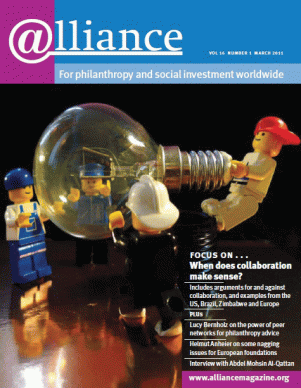Richard Best details many of the downsides of collaboration in organized philanthropy. He touts the virtues of independent action. This may be prudent for a particular project – be it research or development – if you can afford it and when it leads to unencumbered findings or action. But I come from a world where sufficient resources and sustainable outcomes can be achieved only through collaborative effort. In today’s age of austerity, political gridlock, cynicism, diminishing government resources and intractable problems, collaboration is essential to get good work done and make it stick, especially at community level.
I’m a community developer who believes in building community from the bottom up. I’m also an economist, interested in data, trends, efficiency and effectiveness. And I lead a community foundation that helps people invest in their hometowns and generate public good in all its forms.
The Nebraska Community Foundation (NCF) is a community development institution that uses philanthropy as a tool. We are a decentralized system of over 200 affiliated funds located in 77 of Nebraska’s 93 counties. We utilize a bottom-up approach that builds on community strengths by identifying local assets rather than focusing on deficiencies.
The challenge we face in most of Nebraska is outmigration, especially of middle-class youth, caused by the consolidation of production agriculture and the lack of diversity in our rural economy. The result is fewer career opportunities and severe underemployment. This problem can’t be solved with unilateral action. It can be solved only by bringing people of good faith to the table to determine how best to move forward. In short, by a collaborative approach.
Harvard political scientist Robert Putnam states that building collaborative communities must begin by fostering social capital (mutually supportive relationships to help solve problems). Further, Putnam hypothesizes that building social capital helps make democracy work.
Community development, done well, is a democratic process led by the community. Community members end up owning and taking pride in what they’ve done. The collaborative model NCF uses relies on the intelligence and integrity of community leaders. We believe sustainable solutions for community renewal must be led by community members. Outside experts should not impose their values or strategies on the community; they should focus on educating, facilitating, providing technical expertise and helping the community move to strategy and action faster.
People are most likely to act when asked by someone they know and trust. Our model therefore relies on local fund leaders asking their friends and neighbours to invest in the future of their hometown. Further, we believe that decisions about local priorities should be determined locally. All grantmaking decisions for an affiliated fund are therefore made by the local fund leaders. NCF’s role is to act as a value-added partner for its affiliated funds. We do not replace existing community capacity; we enhance it with education, training and technical assistance.
Collective impact – the commitment of key actors from different sectors with a common agenda for solving a specific social problem – is what the NCF collaborative model is attempting to achieve. John Kania and Mark Kramer[1] have detailed five conditions of collective success: common agenda, shared measurement systems, mutually reinforcing activities, continuous communication and a backbone support organization.
NCF has 1,800 community leaders serving as fund leaders. Our decentralized approach, asking community leaders to engage their neighbours, is working. Last year, 7,794 gifts were made to 139 affiliated funds. In the past five years 36,353 gifts have been made and over $70 million has been reinvested in Nebraska through NCF-affiliated funds.
More importantly, community outcomes demonstrate that our collaborative approach works. Distressed rural communities are making grants that are creating new economic opportunities, helping community members acquire new skills, building community facilities and helping former residents return home to raise their families and build their careers. An NCF affiliated fund leader put it best: ‘We’re not giving our kids luggage for graduation anymore.’ None of this would be possible without collaboration and our quest for collective impact.
Collaboration isn’t appropriate in all circumstances, but if the issue you’re struggling with is one that requires large-scale social change, a collaborative approach is probably your best shot at achieving long-term results.
1 John Kania and Mark Kramer (2010) ‘Collective Impact’ in Stanford Social Innovation Review http://www.ssireview.org/articles/entry/collective_impact
Jeff Yost is president and CEO of the Nebraska Community Foundation. Email jeffyost@nebcommfound.org





Comments (0)